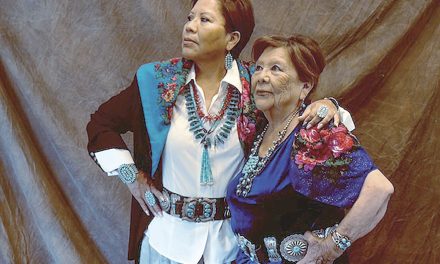
Chiiłchinbii’tó natives own right to access water
By Paul Madson
Editor’s note: Paul Madson is the president of the Chiiłchinbii’tó Chapter.
We have been deprived of our rights to access the C Aquifer. Who makes the decisions—NGOs based outside the reservation, or the people who live on the reservation?
As the President of the Chilchinbeto Chapter, I have been working over the past four years to enable the development of a pumped storage hydroelectric (PSH) project on our chapter land. This clean energy project will facilitate the integration of more intermittent renewable energy, such as solar and wind, into the regional grid, benefiting both the grid of the Navajo Nation and the grid of the Southwest.
Additionally, it will create 1,000 jobs during the three years of construction and 100 permanent direct and indirect jobs afterward, lasting for over 100 years. This project will provide our young people with the opportunity to benefit from vocational training, allowing them to work within the Navajo Nation instead of moving away to find employment, as many have done before. Too often, this trend has left our land with only young children and grandparents. As an electrician by background, I dream of establishing a School of Energy on our Chapter land, which this project could help realize.
Furthermore, the project will bring much-needed income to the Navajo Nation at a time when high royalties from coal mining are under threat. The Navajo Nation urgently needs resources to fund essential programs in healthcare, education, and police services. This technology is also a far more attractive and responsible alternative to lithium-ion batteries with half the carbon footprint and no dependencies on China and cartels of rare raw materials.
The project will rely on a well-proven technology that has been around for 100 years. This technology involves pumping water from a lower reservoir to an upper reservoir when energy is cheap, such as solar energy during the day, and releasing that water when energy is expensive at night when the sun is gone. It will utilize two water reservoirs, each approximately 200 acres in size, equivalent to squares with sides of 3,000 feet. The water will not be consumed; it will operate in a closed loop system. The project will only need to compensate for evaporation, which will be minimized by using floating solar panels.
Water could potentially come from the newly negotiated Arizona water rights, but the timeline for this is too far off for the needs. Instead, the project plans to access the C Aquifer, a vast body of water that extends beyond the border of the Navajo Nation and recharges significantly each year, to the tune of 290,000 acre-feet. The C Aquifer is already widely used by communities outside the Navajo Nation. The total annual pumping from the C Aquifer is 140,000 acre-feet. Ninety-nine percent of this occurs outside the Navajo Nation, primarily for three carbon dioxide-emitting power plants and municipal water needs along 1-40 in communities such as Holbrook, Winslow, and Flagstaff. In contrast, the Navajo Nation is pumping only 1 ,200 acre-feet per year, which is less than 1% of the total. indicating that we are underutilizing this aquifer.
In the Chilchinbeto area, this water is very deep and needs to be cleaned. Only a project like this has the capability to fund the $35 million required to bring this water to Chilchinbeto. The project will need 5,000 acre-feet of water per year for two years to fill the reservoirs and only 2,500 acre-feet per year thereafter to compensate for evaporation. Consequently, the project is ready to make 2,500 acre-feet of water per year available to the Navajo Nation to help meet our basic needs, such as opening a
laundromat or supporting our grazing animals. With just 500 acre-feet of water, we can graze an additional 22,000 cows per year using pivot irrigation techniques. The quantity of water involved in the project is minimal relative to the total quantity available. The 5,000 acre-feet per year required represents only 3.57% of the annual pumping from this aquifer, 1.72% of the annual recharge, and 0.00125% of the total quantity of water available in the aquifer.
The C Aquifer is often confused with the N Aquifer. The N Aquifer is a much smaller body of high-quality, shallow water, whereas the C Aquifer is a large body of low-quality water that recharges significantly and is located at great depths, making it hard to reach. The N Aquifer has been partially depleted by irresponsible usage for the slurry of the Black Mesa coal mine for decades. We believe the N Aquifer should be used primarily as a source of drinking water for the Navajo Nation. Another key difference is the PSH project is a clean energy initiative that will help fight climate change.
We also believe that the Navajo Nation should consider using the C Aquifer much more than it currently does. History has shown that water usage creates water rights. The recent Supreme Court decision not to support the Navajo Nation’s claims on its Colorado River water rights demonstrates that when water rights are not utilized, they are often lost. It is not unlikely that an upper authority could one day tell us that our lack of use of the C Aquifer indicates that we do not need it. Our neighbors outside the Navajo Nation are building water rights actively by pumping in the C Aquifer, we are not.
And unfortunately, some NGOs have persuaded certain leaders of the Navajo Nation to abandon the C Aquifer to neighboring communities outside the reservation. They often leverage the irresponsible use of the N Aquifer—a completely different aquifer with opposite features for a totally different project—as justification for this stance. These NGOs have also been opposing our plans to access the C Aquifer. We informed them that during the COVID lockdown, we were unable to wash our clothes for two weeks because the nearest laundromat, located 25 miles away, was inaccessible. In response, they stated that they do not want to see a laundromat installed in Chilchinbeto.
Leaders of these NGOs reside in Flagstaff, Phoenix, or Berkeley, California, where they have constant access to running water and multiple laundromats. They also benefit from numerous job opportunities, whereas Chilchinbeto has only 27 permanent jobs for a population of 1,600.
The Chilchinbeto Pumped Storage Hydropower project, which would access the C Aquifer, has significant support from the residents of Chilchinbeto and the surrounding area. Our Chapter has already voted in favor of the project with two resolutions. Grazing permit holders representing 13,000 acres in the area support the project, which requires a maximum of only 600 acres. The Western Navajo Agency has also overwhelmingly voted in favor of the project, with NGOs opposing the project remaining marginalized.
Several other neighboring chapters, such as Oljato, Ts’ah Bii Kin, and the four chapters of NOST, have similarly expressed their support. Additionally, the four Grazing Rights Officials of District 8 have signed a letter of support.
Do NGOs funded by distant Silicon Valley billionaires, with leaders living outside the reservation, have more influence over the policies of the Navajo Nation than the people who live here and have expressed broad support for a project accessing the C Aquifer?
Additionally, the people of Chilchinbeto own the right to access the water located under Chapter land. However, based on a recommendation by non-elected individuals living outside the reservation, it appears that the Navajo Nation has decided to deprive us of our right to access this water. We believe that this decision should be our responsibility and that we should have been consulted before it was made.








 Highway 264,
Highway 264, I-40, WB @ Winslow
I-40, WB @ Winslow